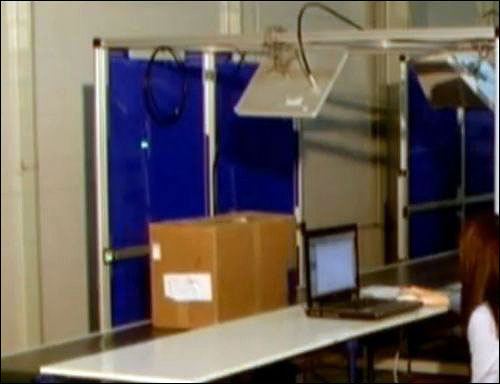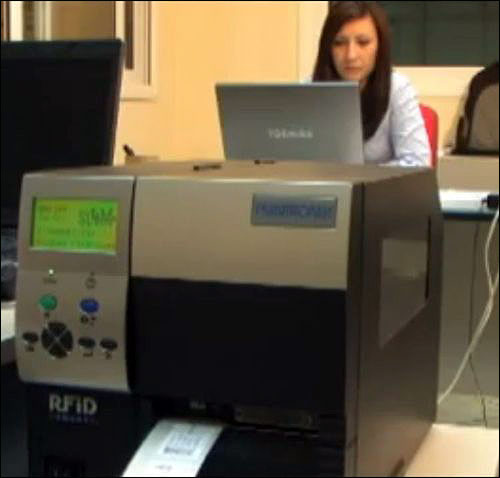Oct 01, 2010Staff Jeans, a Greek clothing company that already employs radio frequency identification to track apparel at the item level in its factories and DC, is expanding its use of RFID to include value-added services at the point of sale at the company's biggest store, in Athens. The firm is adding an intelligent-shopping function that works with RFID-enabled in-store video screens, as well as an RFID-based checkout system and an RFID-based product-authentication solution for returns.
The company initially implemented RFID in late 2008 for warehouse management—specifically, to automate receiving, picking and shipping processes at a distribution center in the city of Larissa—according to Panos Dimitropoulos, the managing partner of SENSAP, the project's integrator. After redesigning the system in 2009 and achieving read rates of 99.5 percent, he says, Staff Jeans opted to expand the application in early 2010, and now tags all items it produces. The company has spent the last six months fine-tuning and optimizing the use of mobile readers for its picking and packing processes, as well as optimizing the RFID system for processing the higher volume of tagged goods. Dimitropoulos estimates that Staff Jeans will use 800,000 tags this year.

The next phase of Staff Jeans' RFID implementation—which began at the beginning of this month and is expected go live in March 2011—is part of the RFID ROI SME project, a European-funded project designed to demonstrate how radio frequency identification can be a productivity tool for small and midsize companies (see RFID-ROI-SME Project Promises Big Help for Small Business).
According to Arsenis Apostolakopoulos, who heads up Staff Jeans' logistics department and helped implement the project, the retailer plans to offer its customers the opportunity to avail themselves of a personal-shopping service. Shoppers will first check in for the service by picking up a passive EPC Gen 2 RFID tag that can be worn around the neck on a lanyard while they are in the store. If customers provide basic information, such as their size, they can receive specific suggestions regarding garments that might fit them. As a patron moves about the store and passes a video screen mounted on a wall, nearby Impinj Speedway readers will interrogate the RFID tag he or she is wearing, as well as the tags of any items that individual is carrying. This information will be processed in the store's back-end database, and stock photos of items will appear on the monitor to provide suggestions about what to wear with that person's selections. The company expects to set up two or three RFID-enabled monitors in the store.
When it's time to check out, a clerk will scan each item's RFID tag at the counter and make it possible for the customer to pass through an anti-theft portal without setting off an alarm, by deactivating certain elements of the tag, which will then remain in the garment after purchase. If the customer later decides to return that outfit, its tag will serve as proof that the item is original and was purchased from a Staff Jeans location.
"The tag lets us know for sure that what the customer is returning was bought in our store or online shop," Apostolakopoulos says.
Staff Jeans originally approached SENSAP about providing it with an automated-identification system to track the thousands of articles of clothing that it processes each day. Due to the quickly changing nature of fashion items, and the short retail sales cycles, the company must document the garments it receives daily at its distribution center in Larissa from production sites in Bulgaria, Romania, Italy and China. Before RFID was implemented, some 15 to 20 workers were employed at the DC just to count garments and create handwritten lists of goods received.
The distribution center must also fill orders for stores—its own, as well as those operated by other retailers—within 48 hours of when the goods arrive from the factories. To speed the processing time of fashion items, workers at the DC now send garments tagged at the clothing factory through a reader tunnel. The DC can process more than 10,000 incoming items per day, with far fewer employees on staff. According to Dimitropoulos, each clothing article's RFID label contains a UPM Raflatac Satellite RFID tag made with Impinj's Monza 3 chip. The Satellite tag's antenna design allows for near- and far-field performance. The distribution center uses a Printronix SL4M printer-encoder to encode each RFID label with a 96-bit EPC consisting of a Serialized Global Trade Item Number (SGTIN), and print it with related bar-coded information and text. The DC ships the tags, together with raw materials and the order description, to manufacturing sites. The factory then attaches the RFID labels to the finished items—such as belts, jeans and tops—before those garments are packed in boxes and shipped to the Larissa DC.

When the boxes arrive at the DC, Dimitropoulos says, a worker applies an RFID tag to each box's exterior and then sends that carton through a reader tunnel equipped with a total of six antennas (two near-field and four far-field), thereby enabling a 99.5 percent read accuracy. Once the tag ID numbers of the garments and the box have been captured, the items in the carton are associated in the computer system with the box's ID number. The system also generates a list of items in each carton, and automatically allocates those goods to particular picking or storage areas. A monitor mounted near the reader tunnel shows workers a stock picture of the articles of clothing within the box, to help them keep a better overview of where specific goods are to be stored.
Since all items within each box have been identified, workers no longer have to open a carton to inspect its contents before moving it to the picking, package or storage area. Instead, the system provides a list of goods received, along with descriptions of each box's contents and instructions indicating where to direct or store that carton.
In the next step, workers begin filling orders received from retail stores. The orders are uploaded into the computer system, which reviews the merchandise on hand in the warehouse and determines which orders can be fulfilled immediately. According to Dimitropoulos, the computer system relies on algorithms to optimize the picking process, then generates packing lists that are sent to mobile handheld computers with RFID readers.
A worker viewing a list of items on the handheld's screen sees a box number and knows where to find a particular item. When that individual approaches a box to be picked, he or she uses the handheld computer to interrogate the RFID label attached to that carton, as well as the labels of all garments removed. Staff Jeans utilizes roughly four handheld interrogators for picking, provided by two manufacturers—Nordic ID and Intermec.
Once the order's accuracy has been verified, the box is stored on a pallet. Shortly before being loaded onto a truck for delivery, the box and its contents are identified once more to ensure that the order is still complete. (Frequently, Dimitropoulos explains, employees might take a few items from one box to complete another order.)
"The RFID system knows which orders are still waiting to be filled," Dimitropoulos states. In most cases, workers will use a handheld reader to update the system when removing apparel from one order and placing it in another. However, he notes, if an employee is in a hurry, he or she may skip this step.
For that reason, boxes are moved through the tunnel reader one final time before shipment, in order to make sure packages have the correct contents—and that the contents match the shipping list, which is also generated by the system and is used for invoicing.
It took the project's partners some time to improve the tunnel reader's read rates, Dimitropoulos says, since many of the tagged items in each box contain metal that interfere with the reading. With the original design of the reader hardware, the rate achieved was roughly 85 percent. But by redesigning the tunnel and switching to UPM Raflatac's Satellite tag, he adds, SENSAP was able to raise the read rate significantly. The redesigned system includes near-field antennas and Speedway interrogators from Impinj, as well as far-field antennas from MTI Wireless.
"The solution was the correct combination of reader, reader antenna, distance and orientation of reader antennas, material of which the antenna is made, and the design and material of the label's antenna," Dimitropoulos states.


